University Report: Enterprise Transformation and Innovation Factors
VerifiedAdded on 2022/11/13
|11
|2172
|195
Report
AI Summary
This report delves into the multifaceted realm of enterprise transformation and innovation, examining the core concepts and critical factors that influence organizational change. It begins by defining enterprise transformation and highlighting the pivotal role of innovation in driving these changes. The report then explores the reasons behind failures in transformation processes, including lack of urgency, poor leadership, and ineffective communication. It contrasts successful and unsuccessful transformation scenarios, emphasizing the importance of a clear vision, effective strategies, and employee engagement. The report also identifies key issues and concerns in the transformation process, such as a lack of empowerment, resource misallocation, and communication breakdowns. Finally, it offers recommendations for avoiding failure, including strategic communication, management collaboration, and resource planning. The conclusion summarizes the key findings, underscoring the importance of a holistic approach to enterprise transformation for achieving desired business outcomes.
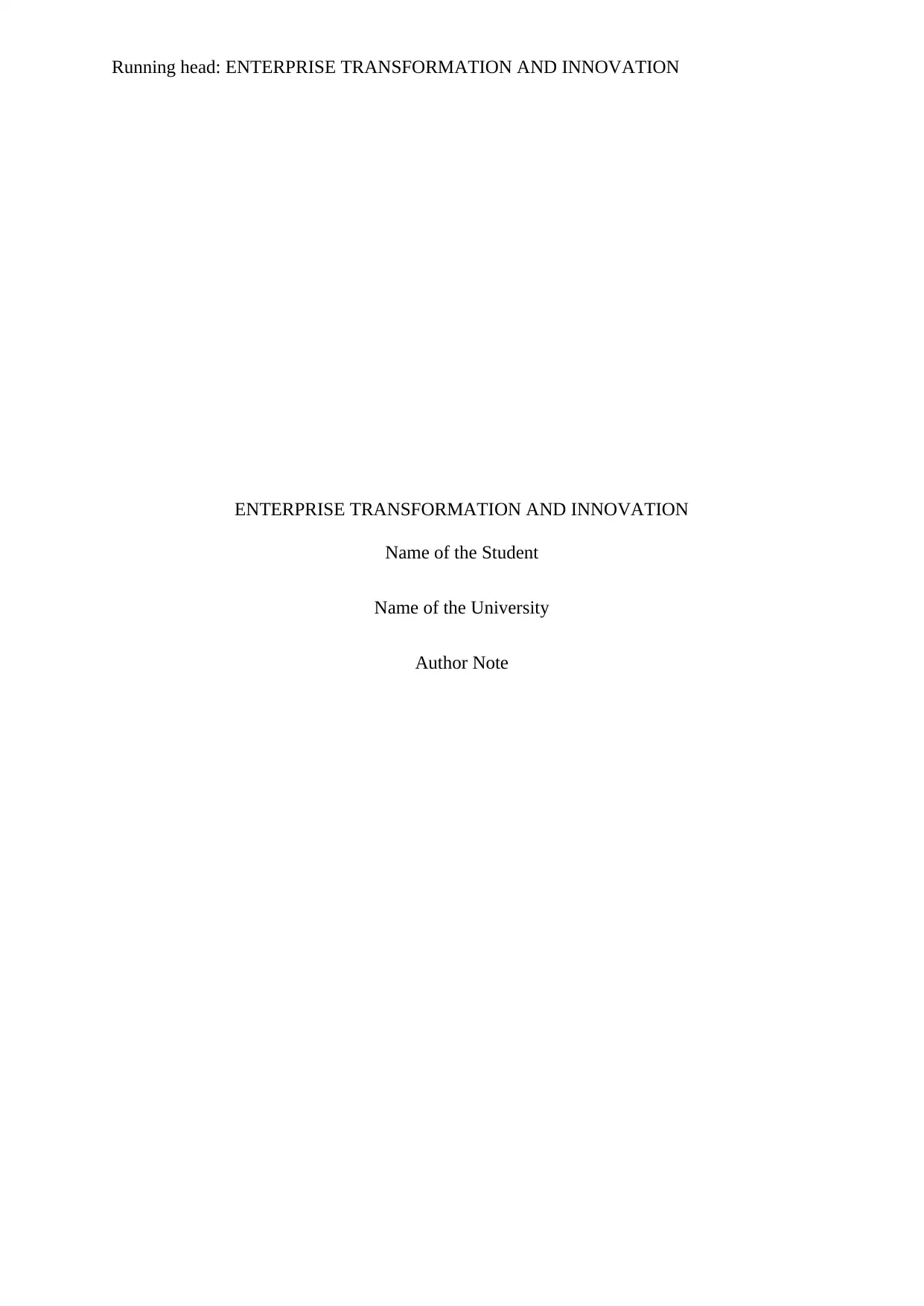
Running head: ENTERPRISE TRANSFORMATION AND INNOVATION
ENTERPRISE TRANSFORMATION AND INNOVATION
Name of the Student
Name of the University
Author Note
ENTERPRISE TRANSFORMATION AND INNOVATION
Name of the Student
Name of the University
Author Note
Paraphrase This Document
Need a fresh take? Get an instant paraphrase of this document with our AI Paraphraser
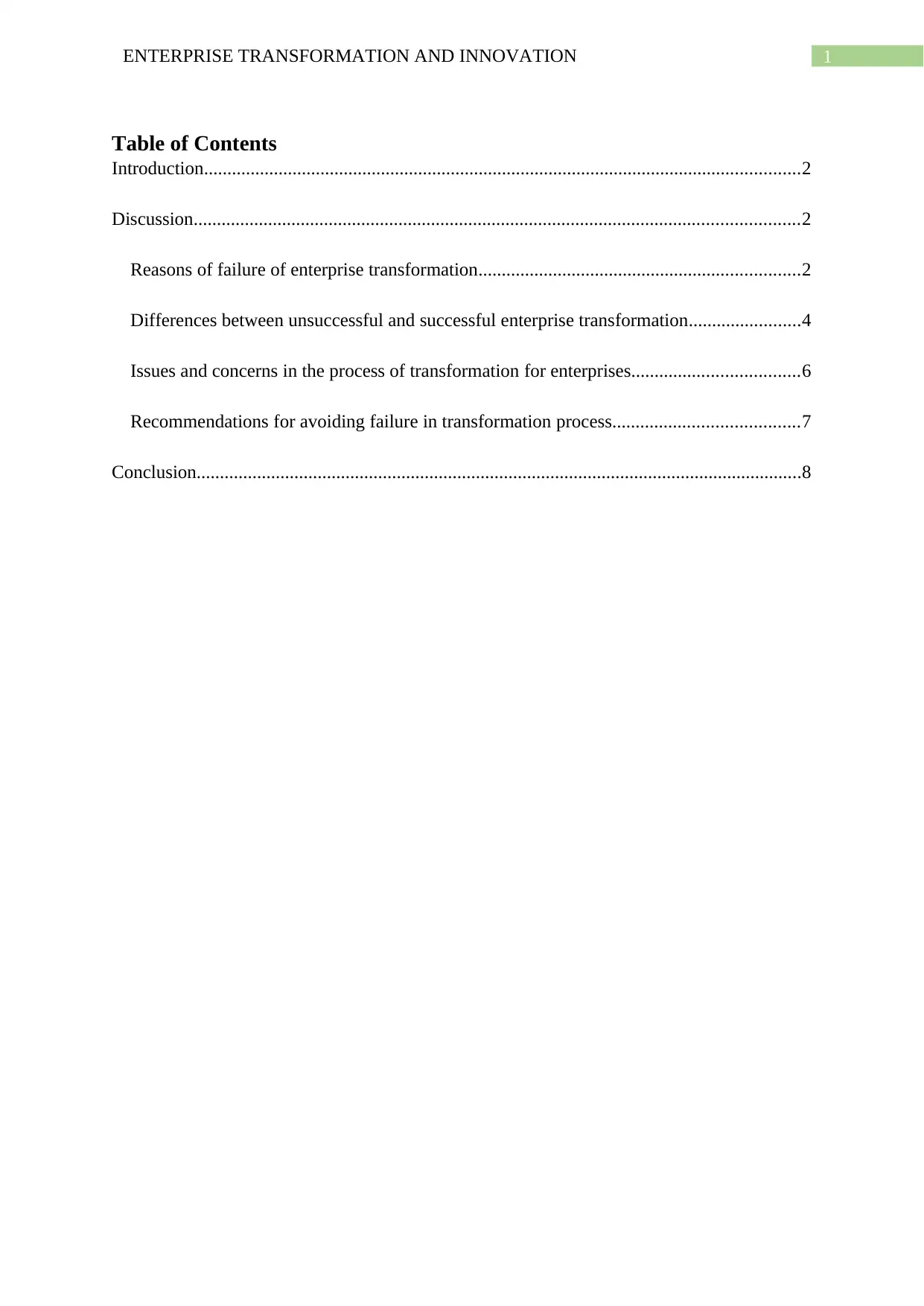
1ENTERPRISE TRANSFORMATION AND INNOVATION
Table of Contents
Introduction................................................................................................................................2
Discussion..................................................................................................................................2
Reasons of failure of enterprise transformation.....................................................................2
Differences between unsuccessful and successful enterprise transformation........................4
Issues and concerns in the process of transformation for enterprises....................................6
Recommendations for avoiding failure in transformation process........................................7
Conclusion..................................................................................................................................8
Table of Contents
Introduction................................................................................................................................2
Discussion..................................................................................................................................2
Reasons of failure of enterprise transformation.....................................................................2
Differences between unsuccessful and successful enterprise transformation........................4
Issues and concerns in the process of transformation for enterprises....................................6
Recommendations for avoiding failure in transformation process........................................7
Conclusion..................................................................................................................................8
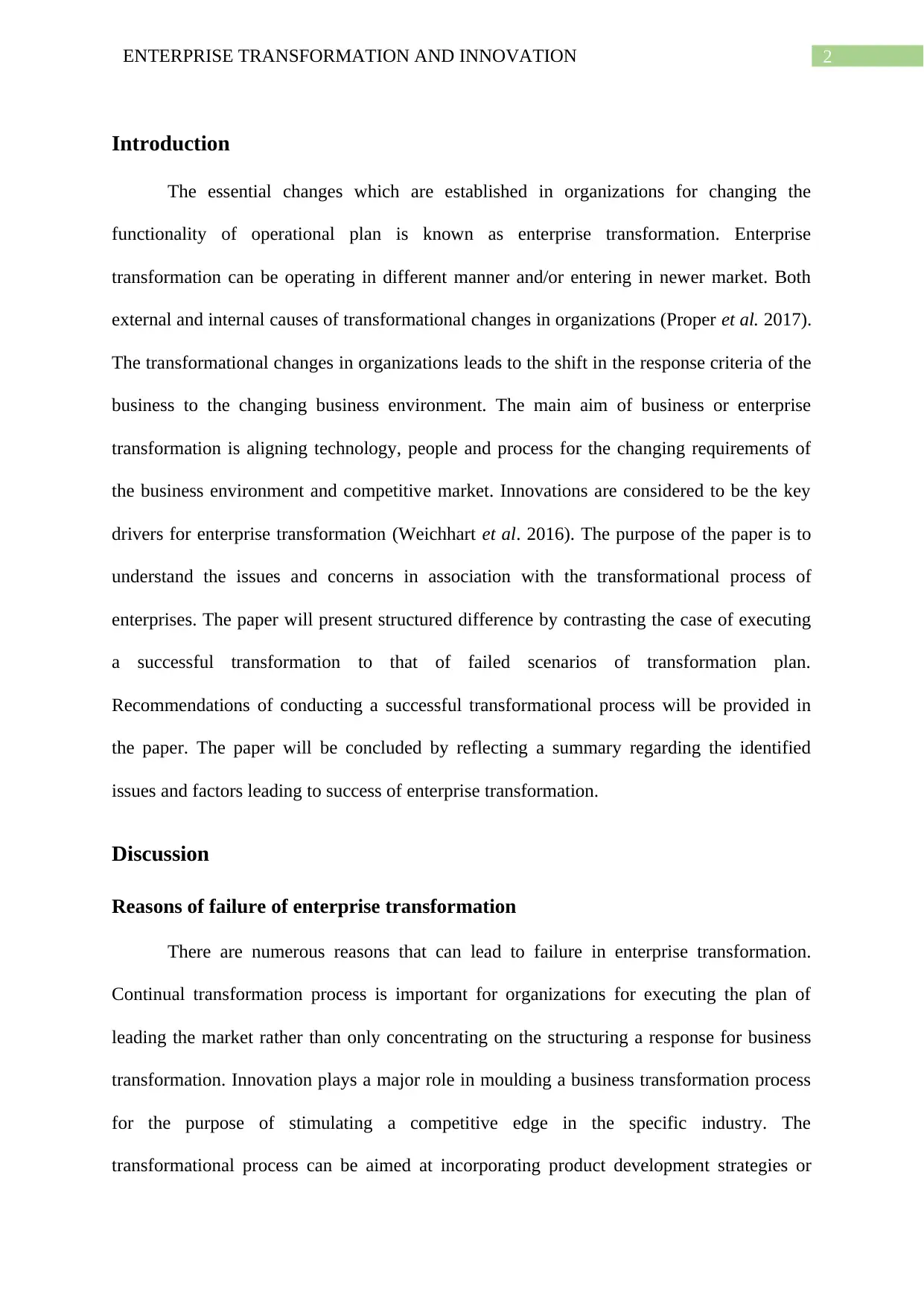
2ENTERPRISE TRANSFORMATION AND INNOVATION
Introduction
The essential changes which are established in organizations for changing the
functionality of operational plan is known as enterprise transformation. Enterprise
transformation can be operating in different manner and/or entering in newer market. Both
external and internal causes of transformational changes in organizations (Proper et al. 2017).
The transformational changes in organizations leads to the shift in the response criteria of the
business to the changing business environment. The main aim of business or enterprise
transformation is aligning technology, people and process for the changing requirements of
the business environment and competitive market. Innovations are considered to be the key
drivers for enterprise transformation (Weichhart et al. 2016). The purpose of the paper is to
understand the issues and concerns in association with the transformational process of
enterprises. The paper will present structured difference by contrasting the case of executing
a successful transformation to that of failed scenarios of transformation plan.
Recommendations of conducting a successful transformational process will be provided in
the paper. The paper will be concluded by reflecting a summary regarding the identified
issues and factors leading to success of enterprise transformation.
Discussion
Reasons of failure of enterprise transformation
There are numerous reasons that can lead to failure in enterprise transformation.
Continual transformation process is important for organizations for executing the plan of
leading the market rather than only concentrating on the structuring a response for business
transformation. Innovation plays a major role in moulding a business transformation process
for the purpose of stimulating a competitive edge in the specific industry. The
transformational process can be aimed at incorporating product development strategies or
Introduction
The essential changes which are established in organizations for changing the
functionality of operational plan is known as enterprise transformation. Enterprise
transformation can be operating in different manner and/or entering in newer market. Both
external and internal causes of transformational changes in organizations (Proper et al. 2017).
The transformational changes in organizations leads to the shift in the response criteria of the
business to the changing business environment. The main aim of business or enterprise
transformation is aligning technology, people and process for the changing requirements of
the business environment and competitive market. Innovations are considered to be the key
drivers for enterprise transformation (Weichhart et al. 2016). The purpose of the paper is to
understand the issues and concerns in association with the transformational process of
enterprises. The paper will present structured difference by contrasting the case of executing
a successful transformation to that of failed scenarios of transformation plan.
Recommendations of conducting a successful transformational process will be provided in
the paper. The paper will be concluded by reflecting a summary regarding the identified
issues and factors leading to success of enterprise transformation.
Discussion
Reasons of failure of enterprise transformation
There are numerous reasons that can lead to failure in enterprise transformation.
Continual transformation process is important for organizations for executing the plan of
leading the market rather than only concentrating on the structuring a response for business
transformation. Innovation plays a major role in moulding a business transformation process
for the purpose of stimulating a competitive edge in the specific industry. The
transformational process can be aimed at incorporating product development strategies or
⊘ This is a preview!⊘
Do you want full access?
Subscribe today to unlock all pages.

Trusted by 1+ million students worldwide
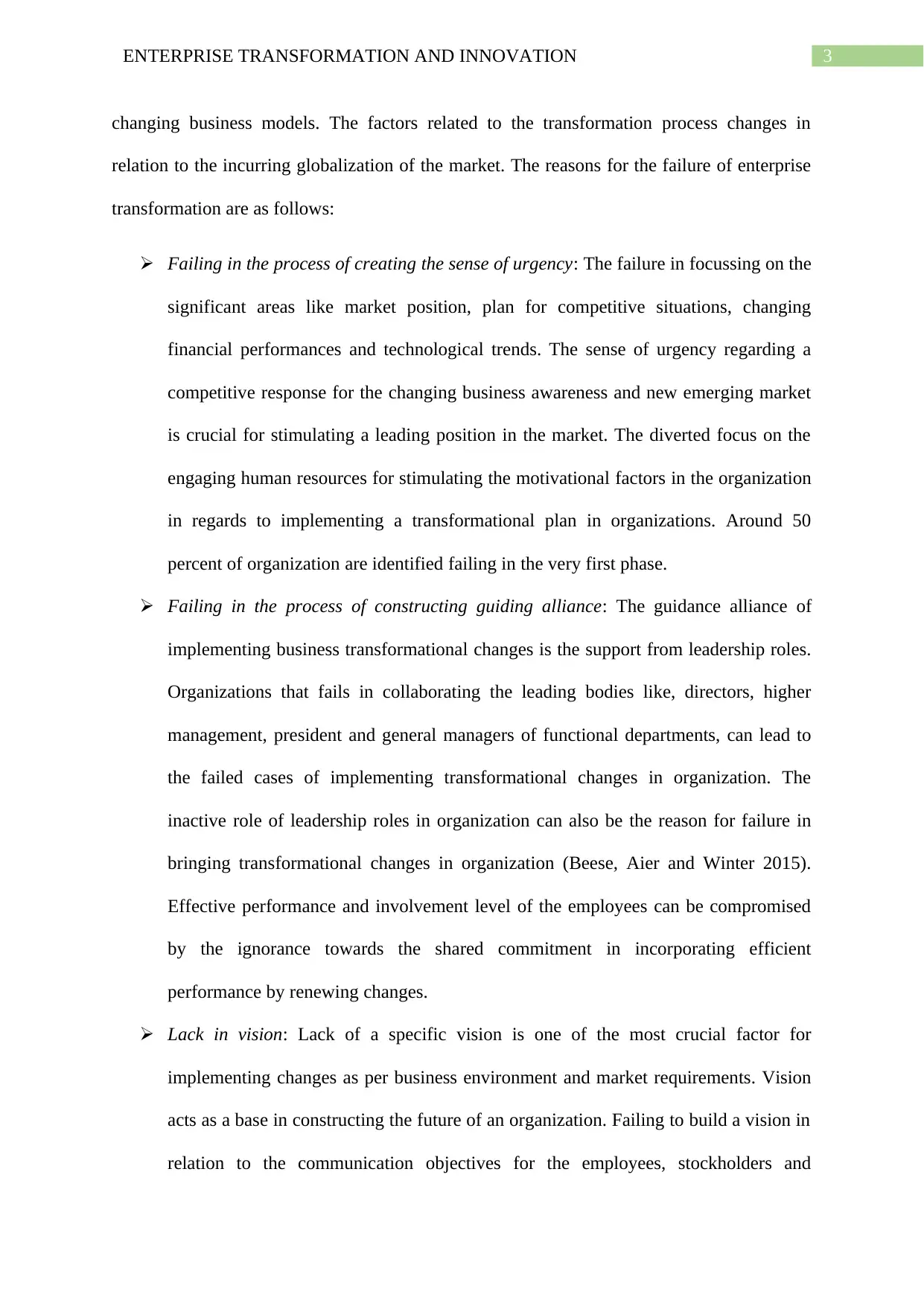
3ENTERPRISE TRANSFORMATION AND INNOVATION
changing business models. The factors related to the transformation process changes in
relation to the incurring globalization of the market. The reasons for the failure of enterprise
transformation are as follows:
Failing in the process of creating the sense of urgency: The failure in focussing on the
significant areas like market position, plan for competitive situations, changing
financial performances and technological trends. The sense of urgency regarding a
competitive response for the changing business awareness and new emerging market
is crucial for stimulating a leading position in the market. The diverted focus on the
engaging human resources for stimulating the motivational factors in the organization
in regards to implementing a transformational plan in organizations. Around 50
percent of organization are identified failing in the very first phase.
Failing in the process of constructing guiding alliance: The guidance alliance of
implementing business transformational changes is the support from leadership roles.
Organizations that fails in collaborating the leading bodies like, directors, higher
management, president and general managers of functional departments, can lead to
the failed cases of implementing transformational changes in organization. The
inactive role of leadership roles in organization can also be the reason for failure in
bringing transformational changes in organization (Beese, Aier and Winter 2015).
Effective performance and involvement level of the employees can be compromised
by the ignorance towards the shared commitment in incorporating efficient
performance by renewing changes.
Lack in vision: Lack of a specific vision is one of the most crucial factor for
implementing changes as per business environment and market requirements. Vision
acts as a base in constructing the future of an organization. Failing to build a vision in
relation to the communication objectives for the employees, stockholders and
changing business models. The factors related to the transformation process changes in
relation to the incurring globalization of the market. The reasons for the failure of enterprise
transformation are as follows:
Failing in the process of creating the sense of urgency: The failure in focussing on the
significant areas like market position, plan for competitive situations, changing
financial performances and technological trends. The sense of urgency regarding a
competitive response for the changing business awareness and new emerging market
is crucial for stimulating a leading position in the market. The diverted focus on the
engaging human resources for stimulating the motivational factors in the organization
in regards to implementing a transformational plan in organizations. Around 50
percent of organization are identified failing in the very first phase.
Failing in the process of constructing guiding alliance: The guidance alliance of
implementing business transformational changes is the support from leadership roles.
Organizations that fails in collaborating the leading bodies like, directors, higher
management, president and general managers of functional departments, can lead to
the failed cases of implementing transformational changes in organization. The
inactive role of leadership roles in organization can also be the reason for failure in
bringing transformational changes in organization (Beese, Aier and Winter 2015).
Effective performance and involvement level of the employees can be compromised
by the ignorance towards the shared commitment in incorporating efficient
performance by renewing changes.
Lack in vision: Lack of a specific vision is one of the most crucial factor for
implementing changes as per business environment and market requirements. Vision
acts as a base in constructing the future of an organization. Failing to build a vision in
relation to the communication objectives for the employees, stockholders and
Paraphrase This Document
Need a fresh take? Get an instant paraphrase of this document with our AI Paraphraser
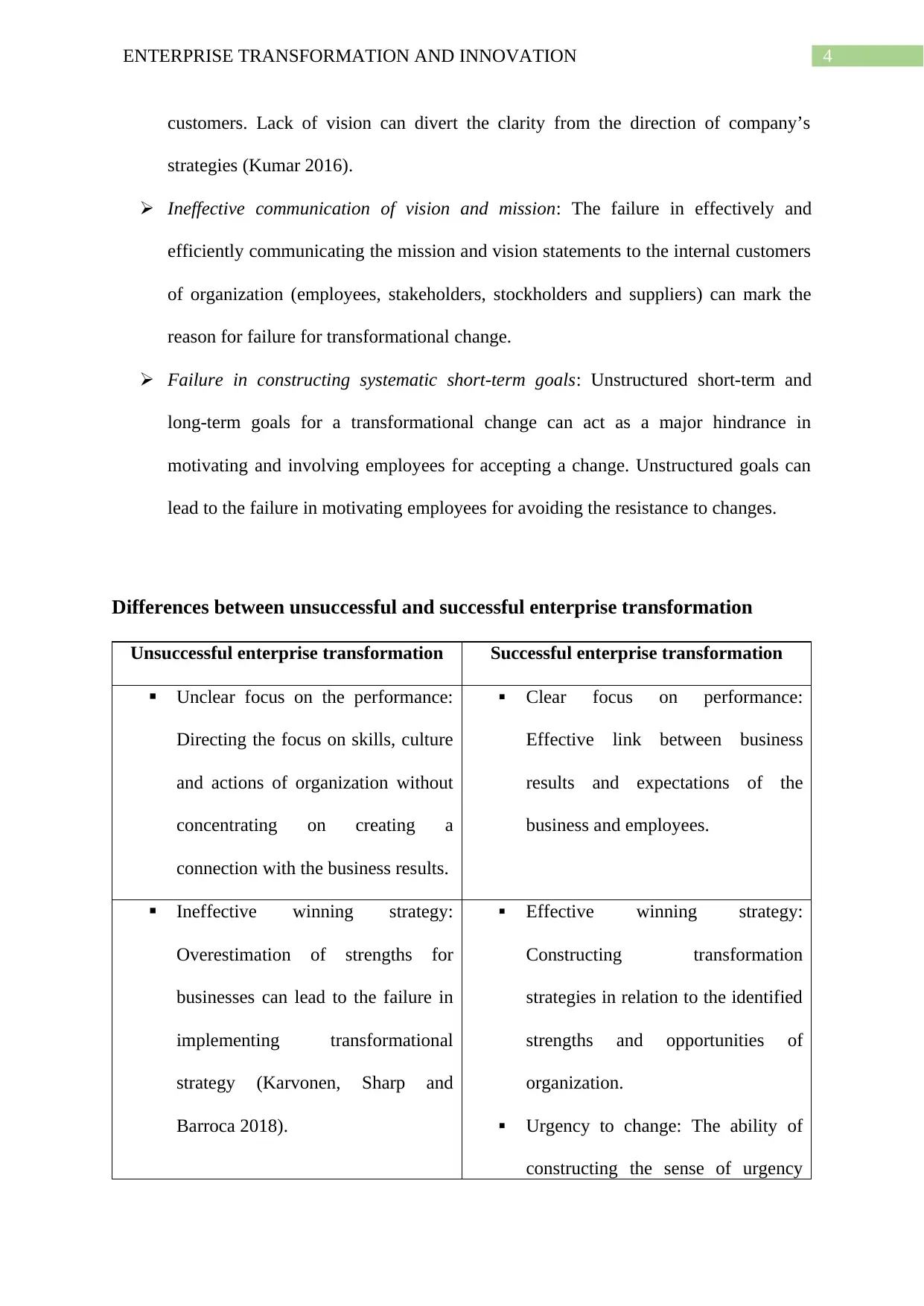
4ENTERPRISE TRANSFORMATION AND INNOVATION
customers. Lack of vision can divert the clarity from the direction of company’s
strategies (Kumar 2016).
Ineffective communication of vision and mission: The failure in effectively and
efficiently communicating the mission and vision statements to the internal customers
of organization (employees, stakeholders, stockholders and suppliers) can mark the
reason for failure for transformational change.
Failure in constructing systematic short-term goals: Unstructured short-term and
long-term goals for a transformational change can act as a major hindrance in
motivating and involving employees for accepting a change. Unstructured goals can
lead to the failure in motivating employees for avoiding the resistance to changes.
Differences between unsuccessful and successful enterprise transformation
Unsuccessful enterprise transformation Successful enterprise transformation
Unclear focus on the performance:
Directing the focus on skills, culture
and actions of organization without
concentrating on creating a
connection with the business results.
Clear focus on performance:
Effective link between business
results and expectations of the
business and employees.
Ineffective winning strategy:
Overestimation of strengths for
businesses can lead to the failure in
implementing transformational
strategy (Karvonen, Sharp and
Barroca 2018).
Effective winning strategy:
Constructing transformation
strategies in relation to the identified
strengths and opportunities of
organization.
Urgency to change: The ability of
constructing the sense of urgency
customers. Lack of vision can divert the clarity from the direction of company’s
strategies (Kumar 2016).
Ineffective communication of vision and mission: The failure in effectively and
efficiently communicating the mission and vision statements to the internal customers
of organization (employees, stakeholders, stockholders and suppliers) can mark the
reason for failure for transformational change.
Failure in constructing systematic short-term goals: Unstructured short-term and
long-term goals for a transformational change can act as a major hindrance in
motivating and involving employees for accepting a change. Unstructured goals can
lead to the failure in motivating employees for avoiding the resistance to changes.
Differences between unsuccessful and successful enterprise transformation
Unsuccessful enterprise transformation Successful enterprise transformation
Unclear focus on the performance:
Directing the focus on skills, culture
and actions of organization without
concentrating on creating a
connection with the business results.
Clear focus on performance:
Effective link between business
results and expectations of the
business and employees.
Ineffective winning strategy:
Overestimation of strengths for
businesses can lead to the failure in
implementing transformational
strategy (Karvonen, Sharp and
Barroca 2018).
Effective winning strategy:
Constructing transformation
strategies in relation to the identified
strengths and opportunities of
organization.
Urgency to change: The ability of
constructing the sense of urgency
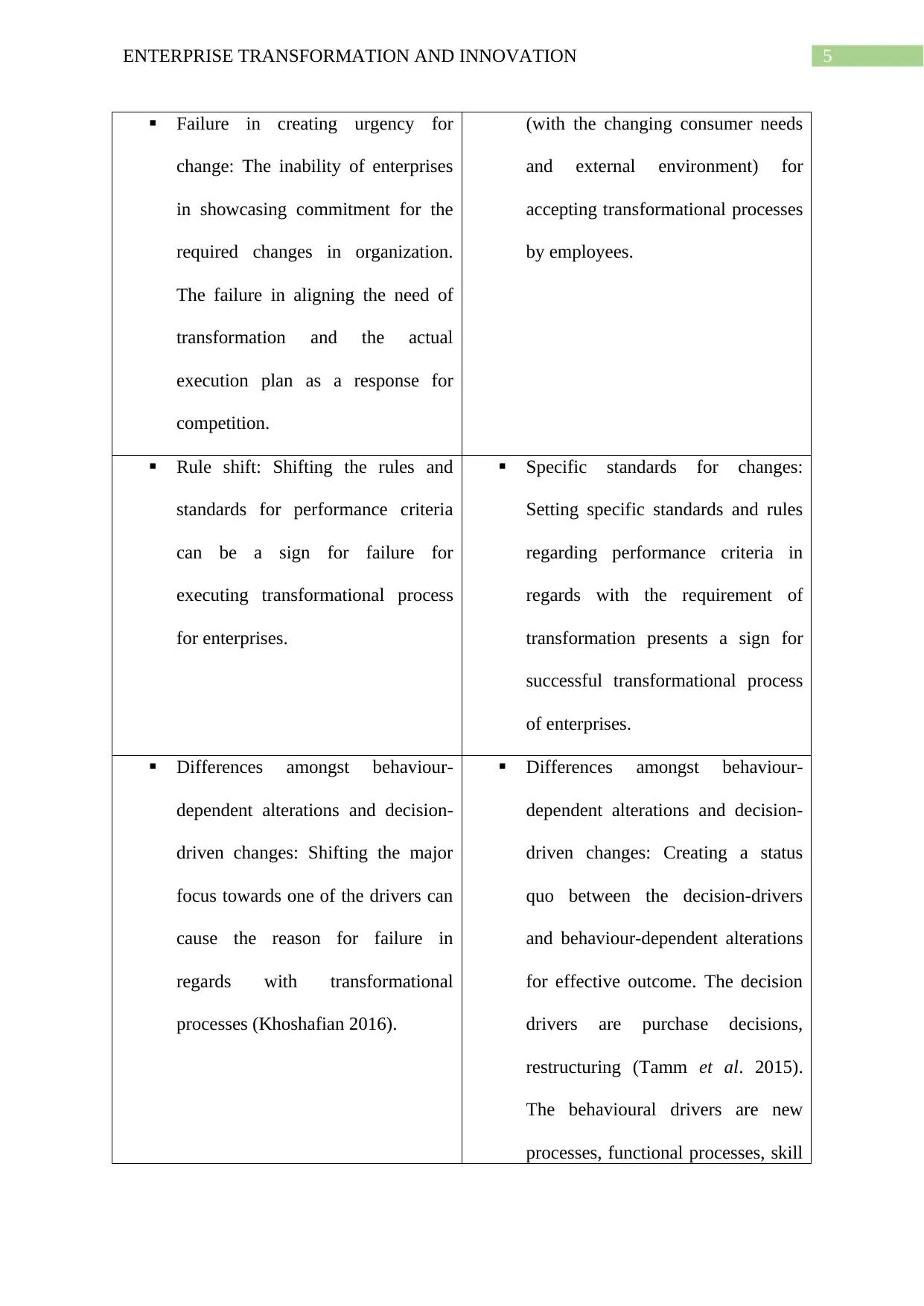
5ENTERPRISE TRANSFORMATION AND INNOVATION
Failure in creating urgency for
change: The inability of enterprises
in showcasing commitment for the
required changes in organization.
The failure in aligning the need of
transformation and the actual
execution plan as a response for
competition.
(with the changing consumer needs
and external environment) for
accepting transformational processes
by employees.
Rule shift: Shifting the rules and
standards for performance criteria
can be a sign for failure for
executing transformational process
for enterprises.
Specific standards for changes:
Setting specific standards and rules
regarding performance criteria in
regards with the requirement of
transformation presents a sign for
successful transformational process
of enterprises.
Differences amongst behaviour-
dependent alterations and decision-
driven changes: Shifting the major
focus towards one of the drivers can
cause the reason for failure in
regards with transformational
processes (Khoshafian 2016).
Differences amongst behaviour-
dependent alterations and decision-
driven changes: Creating a status
quo between the decision-drivers
and behaviour-dependent alterations
for effective outcome. The decision
drivers are purchase decisions,
restructuring (Tamm et al. 2015).
The behavioural drivers are new
processes, functional processes, skill
Failure in creating urgency for
change: The inability of enterprises
in showcasing commitment for the
required changes in organization.
The failure in aligning the need of
transformation and the actual
execution plan as a response for
competition.
(with the changing consumer needs
and external environment) for
accepting transformational processes
by employees.
Rule shift: Shifting the rules and
standards for performance criteria
can be a sign for failure for
executing transformational process
for enterprises.
Specific standards for changes:
Setting specific standards and rules
regarding performance criteria in
regards with the requirement of
transformation presents a sign for
successful transformational process
of enterprises.
Differences amongst behaviour-
dependent alterations and decision-
driven changes: Shifting the major
focus towards one of the drivers can
cause the reason for failure in
regards with transformational
processes (Khoshafian 2016).
Differences amongst behaviour-
dependent alterations and decision-
driven changes: Creating a status
quo between the decision-drivers
and behaviour-dependent alterations
for effective outcome. The decision
drivers are purchase decisions,
restructuring (Tamm et al. 2015).
The behavioural drivers are new
processes, functional processes, skill
⊘ This is a preview!⊘
Do you want full access?
Subscribe today to unlock all pages.

Trusted by 1+ million students worldwide
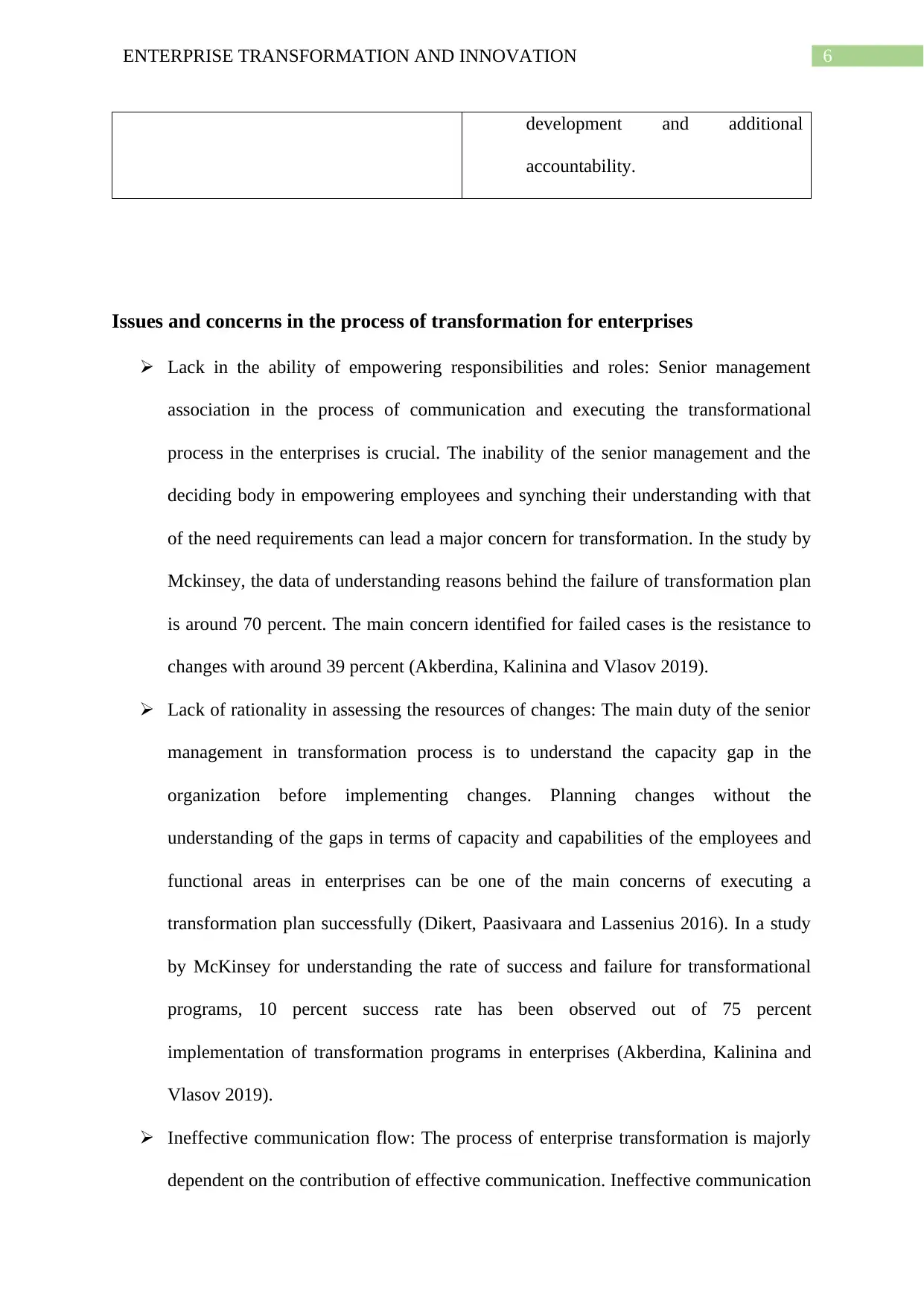
6ENTERPRISE TRANSFORMATION AND INNOVATION
development and additional
accountability.
Issues and concerns in the process of transformation for enterprises
Lack in the ability of empowering responsibilities and roles: Senior management
association in the process of communication and executing the transformational
process in the enterprises is crucial. The inability of the senior management and the
deciding body in empowering employees and synching their understanding with that
of the need requirements can lead a major concern for transformation. In the study by
Mckinsey, the data of understanding reasons behind the failure of transformation plan
is around 70 percent. The main concern identified for failed cases is the resistance to
changes with around 39 percent (Akberdina, Kalinina and Vlasov 2019).
Lack of rationality in assessing the resources of changes: The main duty of the senior
management in transformation process is to understand the capacity gap in the
organization before implementing changes. Planning changes without the
understanding of the gaps in terms of capacity and capabilities of the employees and
functional areas in enterprises can be one of the main concerns of executing a
transformation plan successfully (Dikert, Paasivaara and Lassenius 2016). In a study
by McKinsey for understanding the rate of success and failure for transformational
programs, 10 percent success rate has been observed out of 75 percent
implementation of transformation programs in enterprises (Akberdina, Kalinina and
Vlasov 2019).
Ineffective communication flow: The process of enterprise transformation is majorly
dependent on the contribution of effective communication. Ineffective communication
development and additional
accountability.
Issues and concerns in the process of transformation for enterprises
Lack in the ability of empowering responsibilities and roles: Senior management
association in the process of communication and executing the transformational
process in the enterprises is crucial. The inability of the senior management and the
deciding body in empowering employees and synching their understanding with that
of the need requirements can lead a major concern for transformation. In the study by
Mckinsey, the data of understanding reasons behind the failure of transformation plan
is around 70 percent. The main concern identified for failed cases is the resistance to
changes with around 39 percent (Akberdina, Kalinina and Vlasov 2019).
Lack of rationality in assessing the resources of changes: The main duty of the senior
management in transformation process is to understand the capacity gap in the
organization before implementing changes. Planning changes without the
understanding of the gaps in terms of capacity and capabilities of the employees and
functional areas in enterprises can be one of the main concerns of executing a
transformation plan successfully (Dikert, Paasivaara and Lassenius 2016). In a study
by McKinsey for understanding the rate of success and failure for transformational
programs, 10 percent success rate has been observed out of 75 percent
implementation of transformation programs in enterprises (Akberdina, Kalinina and
Vlasov 2019).
Ineffective communication flow: The process of enterprise transformation is majorly
dependent on the contribution of effective communication. Ineffective communication
Paraphrase This Document
Need a fresh take? Get an instant paraphrase of this document with our AI Paraphraser
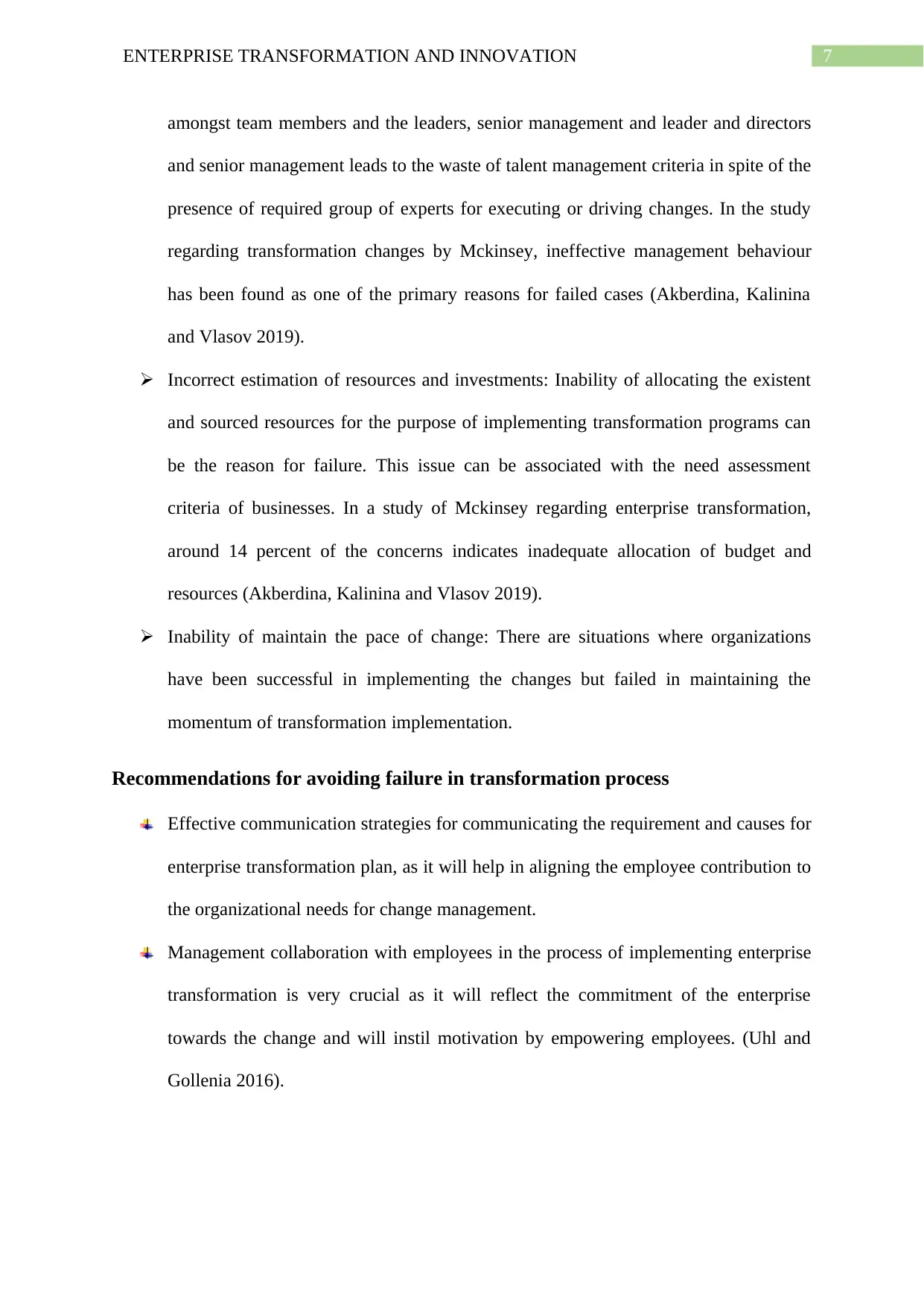
7ENTERPRISE TRANSFORMATION AND INNOVATION
amongst team members and the leaders, senior management and leader and directors
and senior management leads to the waste of talent management criteria in spite of the
presence of required group of experts for executing or driving changes. In the study
regarding transformation changes by Mckinsey, ineffective management behaviour
has been found as one of the primary reasons for failed cases (Akberdina, Kalinina
and Vlasov 2019).
Incorrect estimation of resources and investments: Inability of allocating the existent
and sourced resources for the purpose of implementing transformation programs can
be the reason for failure. This issue can be associated with the need assessment
criteria of businesses. In a study of Mckinsey regarding enterprise transformation,
around 14 percent of the concerns indicates inadequate allocation of budget and
resources (Akberdina, Kalinina and Vlasov 2019).
Inability of maintain the pace of change: There are situations where organizations
have been successful in implementing the changes but failed in maintaining the
momentum of transformation implementation.
Recommendations for avoiding failure in transformation process
Effective communication strategies for communicating the requirement and causes for
enterprise transformation plan, as it will help in aligning the employee contribution to
the organizational needs for change management.
Management collaboration with employees in the process of implementing enterprise
transformation is very crucial as it will reflect the commitment of the enterprise
towards the change and will instil motivation by empowering employees. (Uhl and
Gollenia 2016).
amongst team members and the leaders, senior management and leader and directors
and senior management leads to the waste of talent management criteria in spite of the
presence of required group of experts for executing or driving changes. In the study
regarding transformation changes by Mckinsey, ineffective management behaviour
has been found as one of the primary reasons for failed cases (Akberdina, Kalinina
and Vlasov 2019).
Incorrect estimation of resources and investments: Inability of allocating the existent
and sourced resources for the purpose of implementing transformation programs can
be the reason for failure. This issue can be associated with the need assessment
criteria of businesses. In a study of Mckinsey regarding enterprise transformation,
around 14 percent of the concerns indicates inadequate allocation of budget and
resources (Akberdina, Kalinina and Vlasov 2019).
Inability of maintain the pace of change: There are situations where organizations
have been successful in implementing the changes but failed in maintaining the
momentum of transformation implementation.
Recommendations for avoiding failure in transformation process
Effective communication strategies for communicating the requirement and causes for
enterprise transformation plan, as it will help in aligning the employee contribution to
the organizational needs for change management.
Management collaboration with employees in the process of implementing enterprise
transformation is very crucial as it will reflect the commitment of the enterprise
towards the change and will instil motivation by empowering employees. (Uhl and
Gollenia 2016).
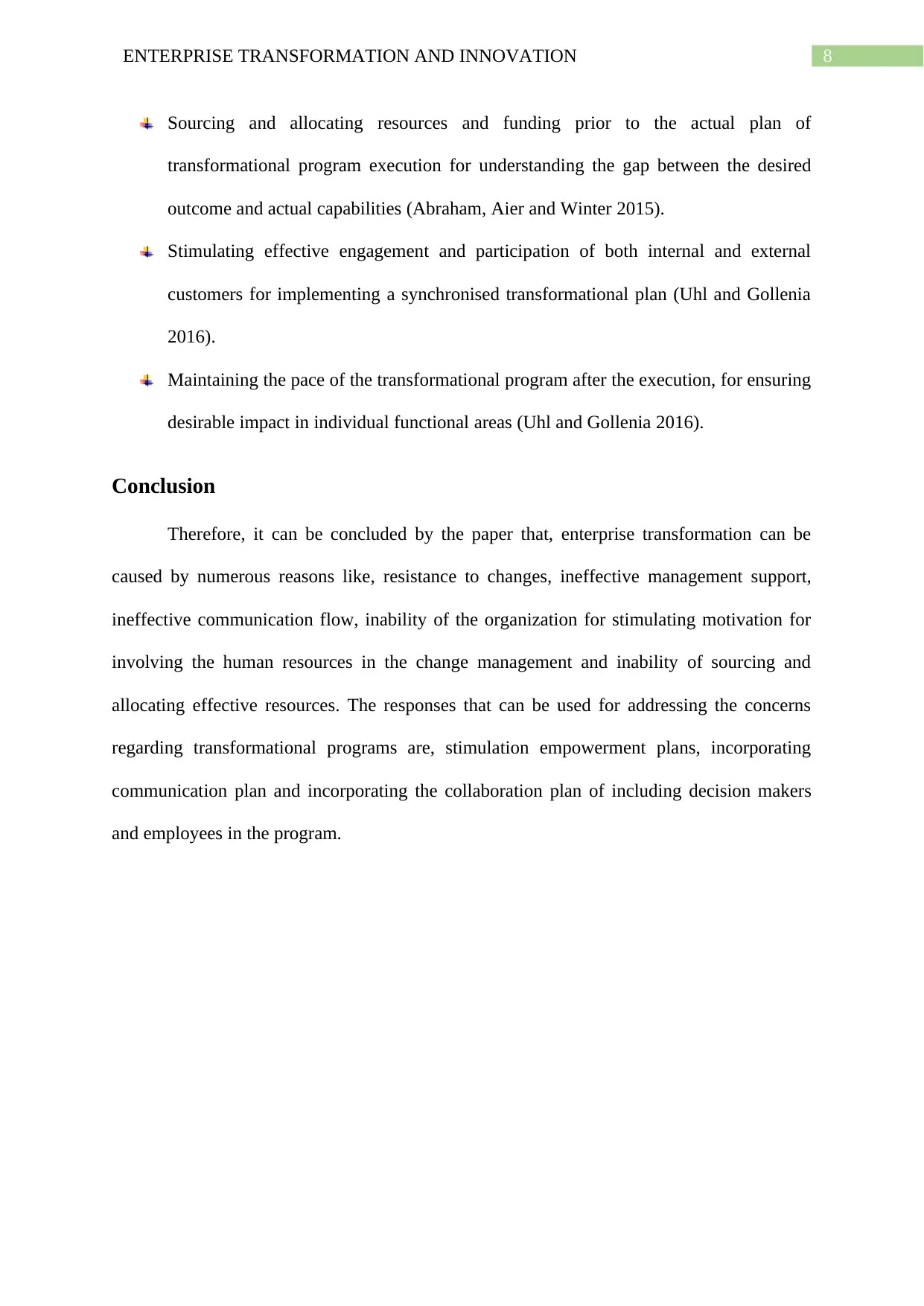
8ENTERPRISE TRANSFORMATION AND INNOVATION
Sourcing and allocating resources and funding prior to the actual plan of
transformational program execution for understanding the gap between the desired
outcome and actual capabilities (Abraham, Aier and Winter 2015).
Stimulating effective engagement and participation of both internal and external
customers for implementing a synchronised transformational plan (Uhl and Gollenia
2016).
Maintaining the pace of the transformational program after the execution, for ensuring
desirable impact in individual functional areas (Uhl and Gollenia 2016).
Conclusion
Therefore, it can be concluded by the paper that, enterprise transformation can be
caused by numerous reasons like, resistance to changes, ineffective management support,
ineffective communication flow, inability of the organization for stimulating motivation for
involving the human resources in the change management and inability of sourcing and
allocating effective resources. The responses that can be used for addressing the concerns
regarding transformational programs are, stimulation empowerment plans, incorporating
communication plan and incorporating the collaboration plan of including decision makers
and employees in the program.
Sourcing and allocating resources and funding prior to the actual plan of
transformational program execution for understanding the gap between the desired
outcome and actual capabilities (Abraham, Aier and Winter 2015).
Stimulating effective engagement and participation of both internal and external
customers for implementing a synchronised transformational plan (Uhl and Gollenia
2016).
Maintaining the pace of the transformational program after the execution, for ensuring
desirable impact in individual functional areas (Uhl and Gollenia 2016).
Conclusion
Therefore, it can be concluded by the paper that, enterprise transformation can be
caused by numerous reasons like, resistance to changes, ineffective management support,
ineffective communication flow, inability of the organization for stimulating motivation for
involving the human resources in the change management and inability of sourcing and
allocating effective resources. The responses that can be used for addressing the concerns
regarding transformational programs are, stimulation empowerment plans, incorporating
communication plan and incorporating the collaboration plan of including decision makers
and employees in the program.
⊘ This is a preview!⊘
Do you want full access?
Subscribe today to unlock all pages.

Trusted by 1+ million students worldwide
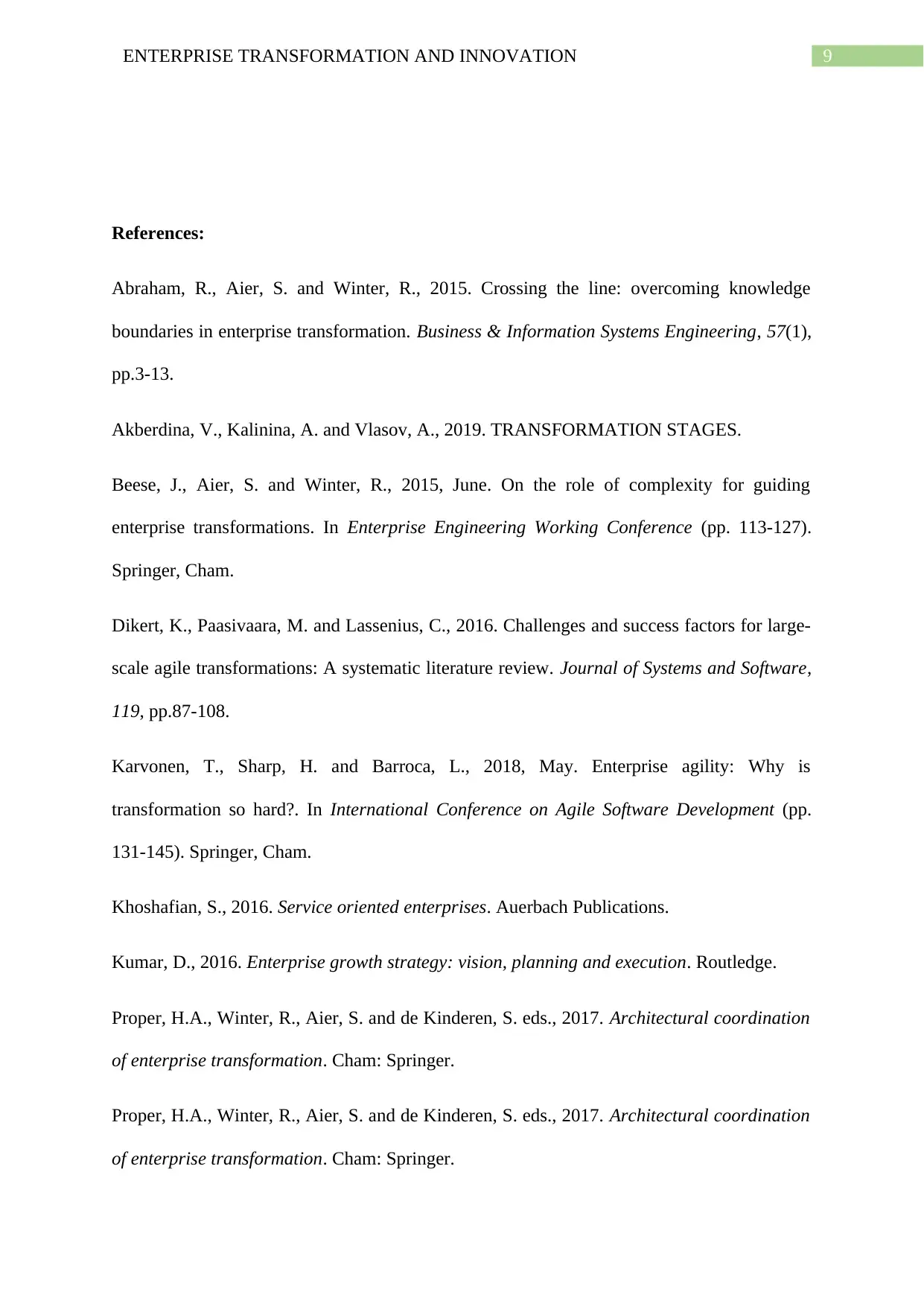
9ENTERPRISE TRANSFORMATION AND INNOVATION
References:
Abraham, R., Aier, S. and Winter, R., 2015. Crossing the line: overcoming knowledge
boundaries in enterprise transformation. Business & Information Systems Engineering, 57(1),
pp.3-13.
Akberdina, V., Kalinina, A. and Vlasov, A., 2019. TRANSFORMATION STAGES.
Beese, J., Aier, S. and Winter, R., 2015, June. On the role of complexity for guiding
enterprise transformations. In Enterprise Engineering Working Conference (pp. 113-127).
Springer, Cham.
Dikert, K., Paasivaara, M. and Lassenius, C., 2016. Challenges and success factors for large-
scale agile transformations: A systematic literature review. Journal of Systems and Software,
119, pp.87-108.
Karvonen, T., Sharp, H. and Barroca, L., 2018, May. Enterprise agility: Why is
transformation so hard?. In International Conference on Agile Software Development (pp.
131-145). Springer, Cham.
Khoshafian, S., 2016. Service oriented enterprises. Auerbach Publications.
Kumar, D., 2016. Enterprise growth strategy: vision, planning and execution. Routledge.
Proper, H.A., Winter, R., Aier, S. and de Kinderen, S. eds., 2017. Architectural coordination
of enterprise transformation. Cham: Springer.
Proper, H.A., Winter, R., Aier, S. and de Kinderen, S. eds., 2017. Architectural coordination
of enterprise transformation. Cham: Springer.
References:
Abraham, R., Aier, S. and Winter, R., 2015. Crossing the line: overcoming knowledge
boundaries in enterprise transformation. Business & Information Systems Engineering, 57(1),
pp.3-13.
Akberdina, V., Kalinina, A. and Vlasov, A., 2019. TRANSFORMATION STAGES.
Beese, J., Aier, S. and Winter, R., 2015, June. On the role of complexity for guiding
enterprise transformations. In Enterprise Engineering Working Conference (pp. 113-127).
Springer, Cham.
Dikert, K., Paasivaara, M. and Lassenius, C., 2016. Challenges and success factors for large-
scale agile transformations: A systematic literature review. Journal of Systems and Software,
119, pp.87-108.
Karvonen, T., Sharp, H. and Barroca, L., 2018, May. Enterprise agility: Why is
transformation so hard?. In International Conference on Agile Software Development (pp.
131-145). Springer, Cham.
Khoshafian, S., 2016. Service oriented enterprises. Auerbach Publications.
Kumar, D., 2016. Enterprise growth strategy: vision, planning and execution. Routledge.
Proper, H.A., Winter, R., Aier, S. and de Kinderen, S. eds., 2017. Architectural coordination
of enterprise transformation. Cham: Springer.
Proper, H.A., Winter, R., Aier, S. and de Kinderen, S. eds., 2017. Architectural coordination
of enterprise transformation. Cham: Springer.
Paraphrase This Document
Need a fresh take? Get an instant paraphrase of this document with our AI Paraphraser
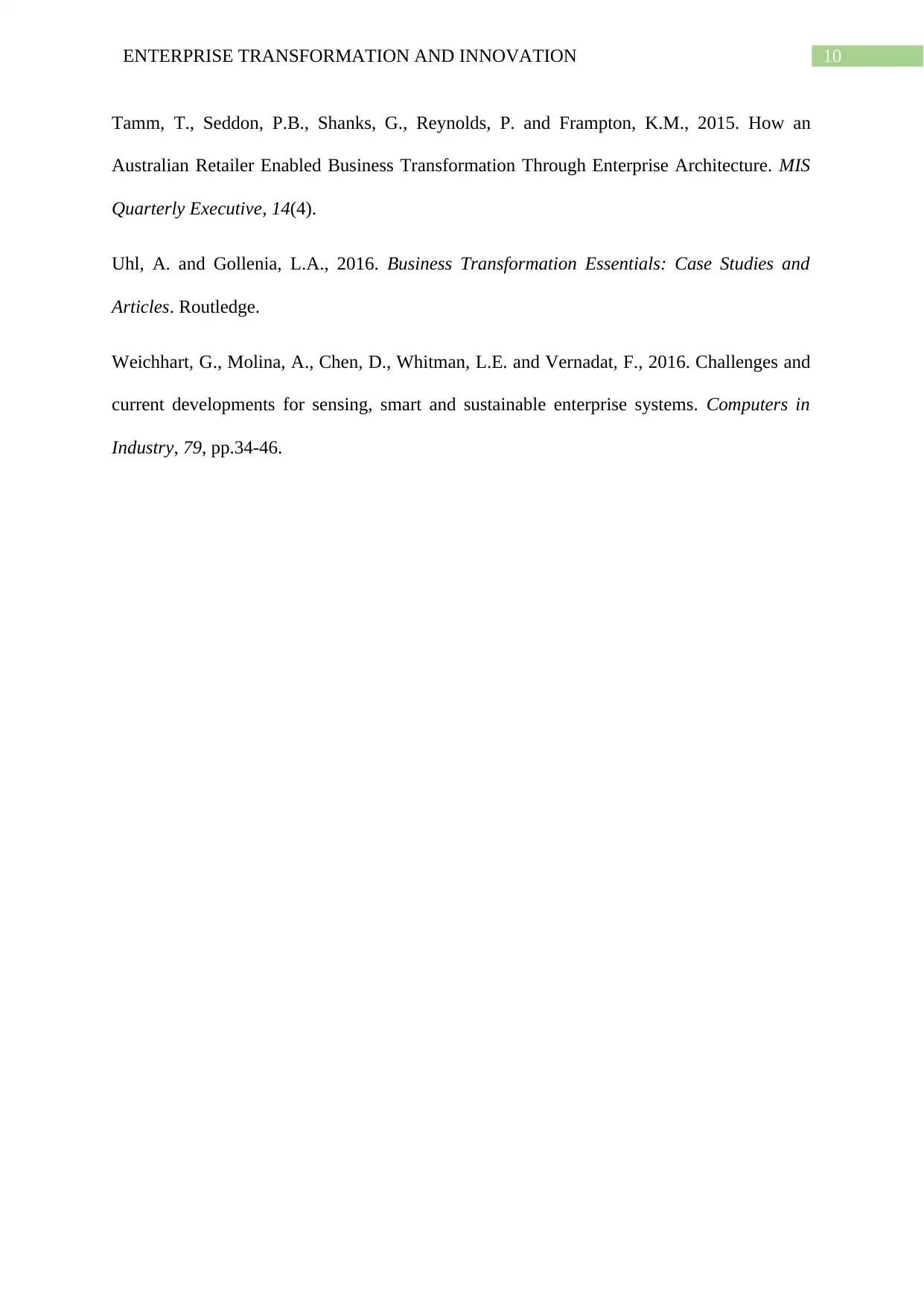
10ENTERPRISE TRANSFORMATION AND INNOVATION
Tamm, T., Seddon, P.B., Shanks, G., Reynolds, P. and Frampton, K.M., 2015. How an
Australian Retailer Enabled Business Transformation Through Enterprise Architecture. MIS
Quarterly Executive, 14(4).
Uhl, A. and Gollenia, L.A., 2016. Business Transformation Essentials: Case Studies and
Articles. Routledge.
Weichhart, G., Molina, A., Chen, D., Whitman, L.E. and Vernadat, F., 2016. Challenges and
current developments for sensing, smart and sustainable enterprise systems. Computers in
Industry, 79, pp.34-46.
Tamm, T., Seddon, P.B., Shanks, G., Reynolds, P. and Frampton, K.M., 2015. How an
Australian Retailer Enabled Business Transformation Through Enterprise Architecture. MIS
Quarterly Executive, 14(4).
Uhl, A. and Gollenia, L.A., 2016. Business Transformation Essentials: Case Studies and
Articles. Routledge.
Weichhart, G., Molina, A., Chen, D., Whitman, L.E. and Vernadat, F., 2016. Challenges and
current developments for sensing, smart and sustainable enterprise systems. Computers in
Industry, 79, pp.34-46.
1 out of 11
Related Documents
Your All-in-One AI-Powered Toolkit for Academic Success.
+13062052269
info@desklib.com
Available 24*7 on WhatsApp / Email
![[object Object]](/_next/static/media/star-bottom.7253800d.svg)
Unlock your academic potential
Copyright © 2020–2025 A2Z Services. All Rights Reserved. Developed and managed by ZUCOL.




